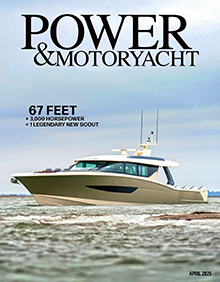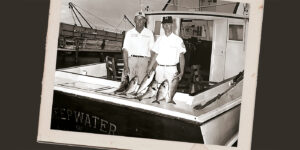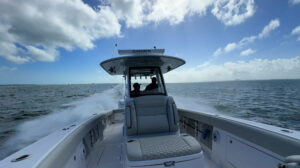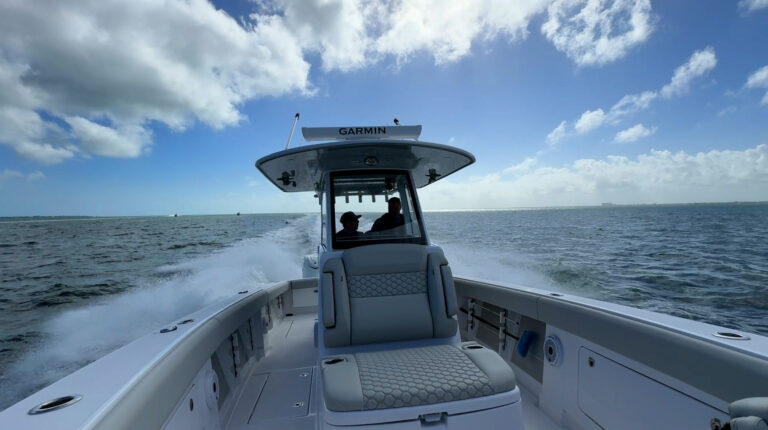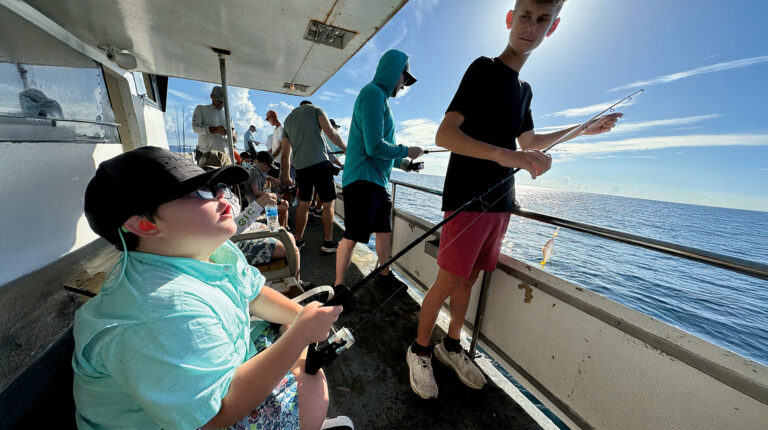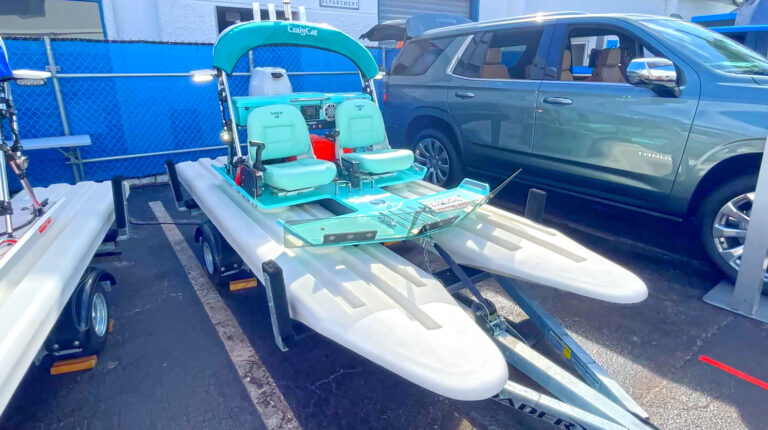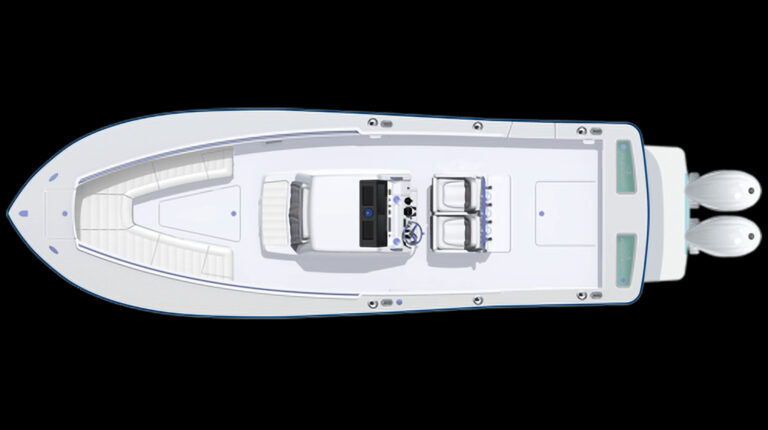
Rendering courtesy of Gamefisherman
It’s a Mother!
Mike Matlack made his mark in fishing boats.
Now he’s trying to in megayachts.
Sportfishing is not just about the fish. While the big-name tournaments and record catches get all the headlines, the adventure and passion of the sport are just as compelling a story. But it all starts with the boat. Owners of the custom cold-molded-epoxy Gamefisherman fishing boats have known that for the last 25 years, but now the builder of them has introduced a megayacht concept to literally bring his sportfishing boats to the world.
Mike Matlack founded Gamefisherman in 1985 when he began building a 40-foot flying-bridge sportfisherman for an acquaintance. Matlack had been building boats since leaving the U.S. Navy in 1964 and had been working at Rybovich since 1980, where he eventually put in five years as president. His first boat is still being fished in Kona, Hawaii.
Matlack says he taught himself boat design based on what he’d seen. “Beyond being functional, [boats] have to be pretty,” he says. “Kind of like women—she has to be pretty.”
It’s not surprising then that the unique lines of a Gamefisherman have attracted experienced owners such as Dennis Deans, a Florida resident and longtime fisherman. About 13 years ago, he saw the 30-foot Gamefisherman Bulldog in the Florida Keys and liked the boat’s sleek shape.
“I wanted a yacht-finish center console,” Deans explains. “[One that’s] simple, but pretty.”
Working with Matlack, Deans built a 37-foot center console that he fished for a few seasons before returning to design and build a 45 express with, he explains, “a few more creature comforts—like a wine rack.” Deans now fishes a 61-foot Garlington, which he acquired when her original owners backed out during construction.
But building a vessel with Matlack and Gamefisherman isn’t just about creating a boat. Most owners, including Bob Brucker, grow to be friends as well as customers. Brucker started out with a 34-foot Gamefisherman, and currently owns a 42-foot express. During the two years his 42-footer was under construction, Brucker would regularly stop into the Stuart shipyard to see the progress.
“Mike’s with you every step of the way and makes it easy,” Brucker said. “It’s like building a home: If you get a good contractor, everything goes smooth.”
Over the last quarter-century, Gamefisherman has built approximately 65 boats, each with her owner welcomed into the process. Though the current economic climate briefly reduced output to a boat or two per year, Gamefisherman launched four in 2011.
Owners like Brucker and Deans tend to stay closer to their home ports of Florida and Virginia. More far-flung sportfishing destinations such as Africa’s Ascension Island or the Peruvian coast require far more range than a 40-footer could manage on her own bottom. But turning that sportfisherman into a megayacht tender not only opens up more distant destinations, it decreases wear and tear on the smaller boat.
That logic explains why in the late 1980s, not long after Gamefisherman’s first launch, the owner of the 167-foot French Look commissioned Matlack to build a game boat/tender, the 40-foot French Look Too. The converted commercial vessel used a railway system to haul the sportfisherman onto the aft deck for transport. It worked but it wasn’t perfect. The railway would move with the mothership, but the sportfisherman might not. “It’s like two people dancing with four left feet,” Matlack explains, pointing out that launching and retrieval are rarely done in totally calm seas.
More generally, Matlack points to two problems in using converted commercial vessels as motherships. The first, he said, is that the loading systems tend to beat up the sportboats as the vessels bob at different rates. And second, the mothership is typically an old boat with old piping, wiring, and engines.
More recently, in 2003, Greg Norman’s former 228-foot mothership Aussie Rules launched with a 42-foot flying-bridge Gamefisherman, No Rules, aboard. The Oceanfast-built megayacht has one key difference from French Look: Her sportfisherman can be unloaded only at a commercial container yard using a double-sling lift.
Noting this key deficiency Matlack thought, “Why not build a mothership from the ground up, with a shoal draft [that would allow her] to get into all ports and yacht clubs?” And so he set out to develop his own mothership platform, partnering with a naval architect who had also worked at Rybovich, Erwin Gerards. The original design was for a 130-footer carrying a 45-foot sportfisherman, but variations at different lengths have emerged based on potential customers’ requests.
“I told him what I had in mind, and he interpreted it perfectly,” Matlack says. “Our hybrid is a workboat-type yacht with a well-finished interior—a floating hunting lodge.”
Indeed, the four-deck megayacht won’t lack for any comfort. The design calls for four guest cabins plus an owner’s deck. The saloon deck will be dedicated to entertaining, the bridge deck has the captain’s cabin, and the sundeck will be for relaxing.
Of course, sportfishing hasn’t been overlooked. Dedicated tackle rooms and rod stowage will be aft, near the sportfisherman. Fuel capacity will be 35,000 gallons, plenty for both yachts. But the biggest innovation will be the launching and retrieval system: a floating dry dock that will be tethered to a winch aboard the mothership and guided to and from her by rollers. When the sportfisherman is launched or retrieved, the steel dry dock with PVC guards first floats free of the ship and then is winched back onboard.
“The dry dock and mothership bump [into each other], not the sportfisherman,” Matlack explains. “[The mothership’s] steel hull is unforgiving.”
When the dry dock is deployed and the sportfisherman is launched, the empty interior well can be filled with water and used as a pool. When it’s not full of water, ballast tanks will keep the megayacht floating at the same level as when she’s fully loaded.
When the sportfisherman is secured aboard, it will be able to operate off the megayacht’s systems. Climate control and electricity will make her habitable for crew or guides and easy to maintain while the mothership is underway.
“If I’d have come up with this ten years ago, there’d be a fleet of them by now,” Matlack laments. Now that it’s here, Matlack’s mothership may well add a new chapter to the annals of sportfishing—the sportfisherman that always has a home away from home.
Gamefisherman
(772) 220-4850.
Specifications
- Builder: Gamefisherman
This article originally appeared in the March 2012 issue of Power & Motoryacht magazine.

